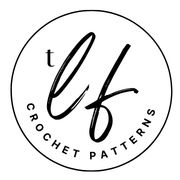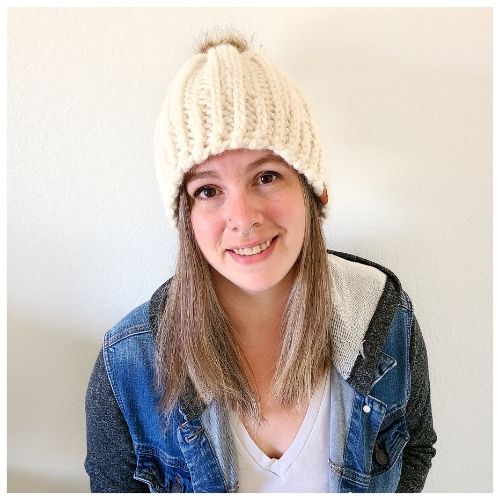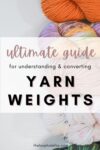Yarn Weight Guide: Everything You Need to Know about Yarn Weight
Yarn weight can be one of the most confusing parts of crochet (or knit), especially when you’re new to the craft.
Beginners aren’t alone in this confusion, either. It can be difficult even for experienced crocheters to understand yarn weight, what it means, when to use certain weights and why a certain weight may be used in a pattern.
This Yarn Weight Guide will walk you through yarn weights, what they mean, what they’re typically used for, how to tell what weight your yarn is if you’ve lost the label and more.
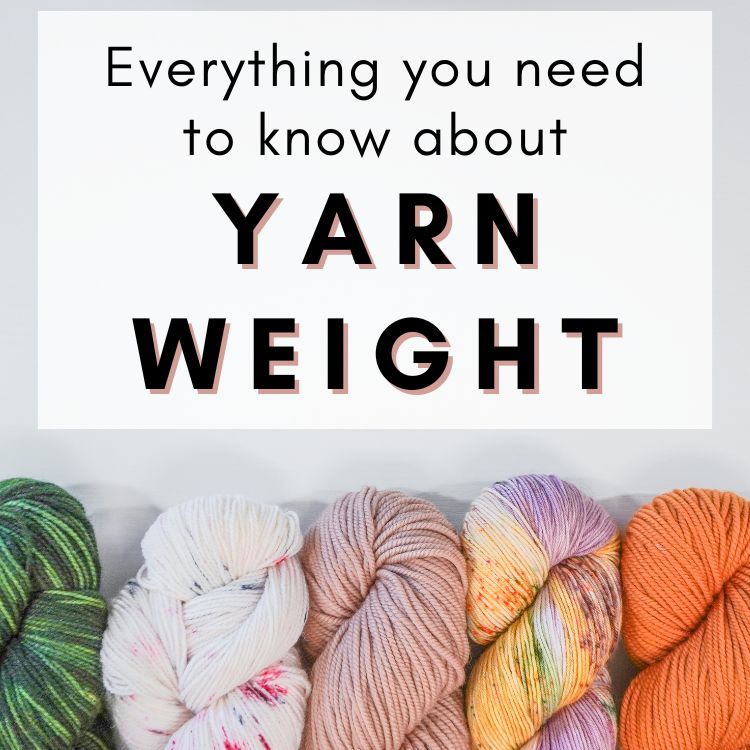
What does Yarn Weight mean?
The term “yarn weight” can seem a little deceiving. Just the word “weight” makes us think of how much something weighs but that is not the case here.
Yarn weight refers to how thick the strand of yarn is in diameter, not how much it weighs.
From there, the different thicknesses of yarn are put into categories, or averages, which are referred to as “yarn weight”.
While “gauge” is not used to define yarn, this is the same as gauge when it comes to wire. If you were to purchase a spool of wire, you would look at the gauge of the wire to understand how thick it is in diameter, not how long it is or how much the spool of wire weighs.
Of course for crochet, gauge is a direct correlation to our personal tension and not the thickness of the yarn.
Don’t let this comparison confuse you – Despite “gauge” being used two different ways here, it is the most direct comparison to help us understand what yarn weight means.
To reiterate: Yarn weight is directly defining how thick the strand of yarn is or the direct diameter of the strand.
The smallest weight of yarn (Super Fine – 0) refers to the thinnest diameter of yarn and the highest weight (Super Jumbo – 7) refers to the thickest diameter.
What are the “standard” categories of yarn weight?
Now that we know what yarn weight means, we can better understand the different categories available to us.
It’s important for yarn to have a set of standard categories. This gives both crocheters and designers a general understanding of yarn thickness and how to use certain yarn weights.
With these categories, crocheters and knitters alike can be aware of the general thickness of yarn they’re purchasing and approximately what the result will be using the yarn.
Yarn Weight Standard (categories) as per the CYC
To give as clear as a set of standards as possible, the Craft Yarn Council (CYC) created a standard system for yarn weight. In the US, this is the most commonly used though it is not an absolutely perfect system.
0 – Lace (Sometimes called Fingering, Cobweb or 10-Count Thread)
Lace (0) weight is the thinnest available yarn.
Lace (0) weight is typically used for very intricate, small and lacy projects like doilies. It can also be used for lacy shawls in which the designer opts to use a much larger hook than recommended to bring in even more of a lacy feel and extra drape.
- Per the CYC:
- Recommended hook sizes: 1.6 to 1.4 mm Steel hooks or 2.25mm (B-1) in “regular” crochet hook sizes.
- Average Gauge: 32 to 42 stitches make up 4 inches in width using the recommended hook size.
- Steel crochet hooks are typically recommended on the label for this weight, which are sized much smaller than “regular” Crochet Hook Sizes which most crocheters are much more familiar with.
1 – Super Fine (Commonly Known As: Fingering or Sock)
Super Fine (1) weight is the second thinnest available yarn and is much more commonly used than its Lace (0) sibling. This weight is often referred to as “Fingering” weight or “Sock”.
Similar to Lace (0), the slightly thicker Super Fine (1) weight is a very thin yarn with a small gauge. This yarn is typically used for lacy shawls, lightweight garments, summer scarves, socks, etc.
- Per the CYC:
- Recommended hook sizes: 2.25mm (B-1) to 3.5mm (E-4)
- Note: Many designers opt to use larger hooks. Most commonly we will see a 4mm (G-6) hook used.
- Average Gauge: 21 to 22 stitches make up 4 inches in width using the recommended hook size.
- Recommended hook sizes: 2.25mm (B-1) to 3.5mm (E-4)
- This yarn is pretty commonly used, though isn’t usually recommended for beginners. Using a much thinner weight of yarn like this can be a little frustrating if you’re new to crochet but it’s certainly not as difficult to use as it’s often made out to be – especially when designers often use bigger hooks than recommended.
2 – Fine (Commonly Known As: Sport or Baby)
Fine (2) yarn weight is just slightly thicker than Super Fine (1) yarn. This weight is often referred to as “Sport” or “Baby” yarn. Sometimes it can also be referred to as “Sock” yarn, though it is not quite as common.
Fine (2) weight yarn is typically used for lightweight projects like baby blankets, scarves, shawls, lightweight sweaters or tops, etc.
- Per the CYC:
- Recommended hook sizes: 3.5mm (E-4) to 4.5mm (7 or G+)
- Average Gauge: 16 to 20 stitches make up 4 inches in width using the recommended hook size.
- This yarn is a good place to start if you’re looking to use thinner weights of yarn but don’t want to jump in with both feet.
3 – Light (Commonly Known As: DK or Light Worsted)
Light (3) weight is almost always referred to as DK though this isn’t the “standard” term in the US (it is in the UK). DK is one of the most popular weights of yarn used. It’s in the “sweet spot” between yarn weights. It can be crocheted much faster than the thinner weights but still provides lovely drape in the finished project.
Light (3) weight yarn is commonly used in almost any type of project you can think of – from baby blankets to shawls to beanies to sweaters, etc.
- Per the CYC:
- Recommended hook sizes: 4.5mm (7 or G+) to 5.5 mm (I-9)
- Average Gauge: 12 to 17 stitches make up 4 inches in width using the recommended hook size.
4 – Medium (Worsted AND Aran)
Medium (4) weight yarn is arguably the most popular yarn used. The popularity of this weight comes from the fact that it can be used for almost any project. Additionally, it’s a fantastic weight for those who are just learning to crochet as it’s in the sweet spot of thickness (so it’s easy to grip and feel) without being too bulky.
Medium (4) includes BOTH Worsted and Aran “weights”. Worsted and Aran are not the same, though they are both considered “Medium”. Worsted is slightly thinner than Aran and leans more toward a Light (3 – DK). Aran on the slightly thicker side and leans more toward a Bulky (5) weight.
Medium (4) weight yarn, whether Worsted or Aran, is commonly used in almost any type of project you can think of – from blankets (adult or baby) to shawls to beanies to sweaters to home decor, etc.
- Per the CYC:
- Recommended hook sizes: 5.5mm (I-9) to 6.5 mm (K-10.5)
- Designers commonly use 5mm (H-8)
- Average Gauge: 11-14 stitches make up 4 inches in width using the recommended hook size.
- Recommended hook sizes: 5.5mm (I-9) to 6.5 mm (K-10.5)
5 – Bulky (Commonly Known As: Chunky)
Bulky (5) weight is the next step up in weight category. This weight is slightly heavier than the Aran yarns in the Medium (4) category, though it’s not so bulky that it’s hard to work with.
This yarn is in the sort of sweet spot between being fast without being too bulky. This provides speed in crocheting so projects work up quickly but it does not usually have good drape.
Bulky (5) weight yarn is commonly used for blankets, beanies, oversized sweaters, scarves, rugs, some home decor like baskets, etc.
- Per the CYC:
- Recommended hook sizes: 6.5mm (K-10.5) to 9 mm (M/N-13)
- Average Gauge: 8 to 11 stitches make up 4 inches in width using the recommended hook size.
6 – Super Bulky
Super Bulky (6) weight is very thick and works up quickly on larger crochet hooks.
This yarn is not typically recommended for beginners. While it’s very thick and would be easy to see the stitches, it’s so thick that it can be difficult to work with and can cause more frustration in learning.
Being so thick, Super Bulky (6) weight yarn is typically used for blankets that should be warm and heavier, bulky statement beanies, scarves, rugs, etc.
- Per the CYC:
- Recommended hook sizes: 9mm (M/N-13) to 15 mm (Q)
- Average Gauge: 7 to 9 stitches make up 4 inches in width using the recommended hook size.
7 – Jumbo
Jumbo (7) weight is the heaviest of yarn weights available. This yarn is incredibly thick and the category typically includes “yarn” such as Roving (which is fiber that has been combed but not spun, so it’s not technically yarn yet).
This yarn, of course, works up super fast and a project will be completed in no time. Using very large hooks or often commonly used for arm crochet or knit projects, the speed in which one can finish a project is astounding.
However, this yarn IS incredibly thick and isn’t always the best option for any sort of project. You will typically see projects such as big and thick blankets, super sized scarves, rugs, etc.
- Per the CYC:
- Recommended hook sizes: 15mm (Q) or larger
- Average Gauge: 6 or less stitches make up 4 inches in width using the recommended hook size (or via arm crochet).
An important note on yarn weight
Just like with clothing, yarn weights in the same category aren’t always going to be exactly the same. This example works especially well when we consider women’s clothing. A size 5 with one brand usually isn’t the same as a size 5 from a different brand.
While yarn weights in the same category may not vary as significantly as size in clothing does, there can be slight differences between manufacturers/brands.
The slight differences in thickness come from many different aspects of the yarn: The fiber, how the yarn was spun or manufactured and even the color of yarn (Yep! The color of the yarn can affect the yarn’s thickness).
It’s important to remember that different yarns will not be exactly the same even if they’re in the same “standard weight” category.
Consider this category an “average” of thickness. There will be some wiggle room in each category but they are all around the same thickness.
This, of course, means that a gauge swatch is important even if your yarn is in the same category of weight as the designer or to a project you’ve made before.
An important note on “recommended hooks”
Recommended hook sizes give you a general idea of what hook size will work with the weight of yarn.
It is not a hard and fast rule but a good starting place. You will often see designers or other crocheters using hook sizes that are not inside this recommended category – and that’s okay!
It’s pretty common for crocheters to use smaller or larger hook sizes depending on what style of project they’re looking for.
This means that you are not “ruled” by these recommendations. You absolutely can just use the recommended hook size and make anything you like but you are not required to.
Does the fiber content of the yarn matter regarding the weight categories?
The short answer is: yes.
While yarn is put into specific categories and all fibers fit into those categories, you’ll find that certain fibers just aren’t anywhere near the same thickness as others.
This is especially true with cotton.
Most 100% cotton yarns are thinner than we might expect them to be considering the category they’re placed in. Medium (4) Cotton yarn is often thinner and closer to a Light (3 – DK) wool or acrylic than it is to a Medium (4) wool or acrylic yarn.
Yarn that is a blend of cotton and acrylic doesn’t have as big of a difference to acrylic or wool as 100% cotton.
Wool, acrylic or blends of the two can also have slight differences.
How do I know what weight the yarn I’m buying is?
The weight of the yarn will be listed on the skein label. The skein label is the paper wrapper that goes on or around the skein of yarn.
Most yarn that’s made by a large manufacturer (think Lion Brand or Red Heart) will have the CYC skein weight icon on the skein and sometimes they have the weight’s “name” below it.
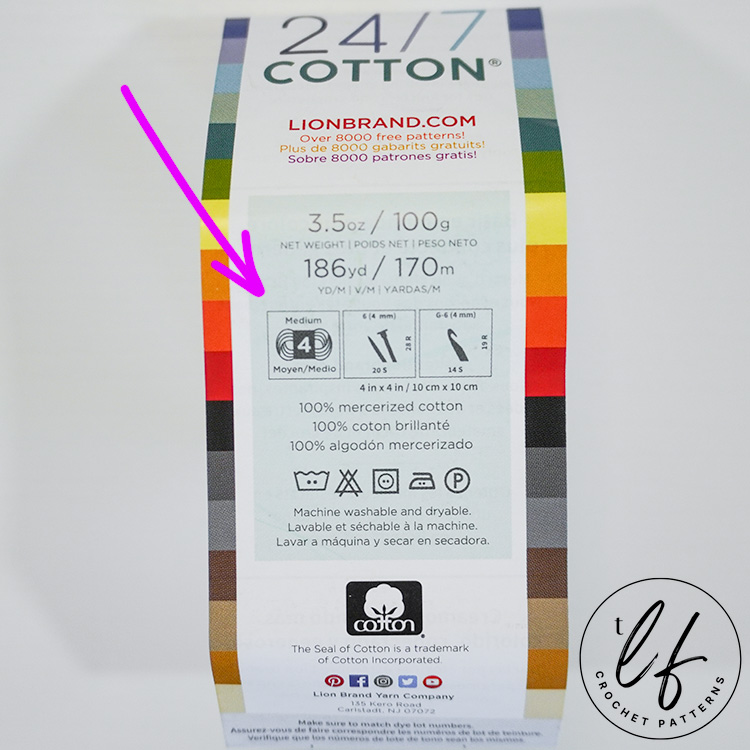
You can see the black and white image of a drawn skein of yarn with a black “label” around it. This is the icon we’re looking for. Inside the black “label”, there is a number. This number references which weight category this yarn falls into.
All skein labels for yarn should state what their weight is either with the icon or via text, even if they’re hand dyed.
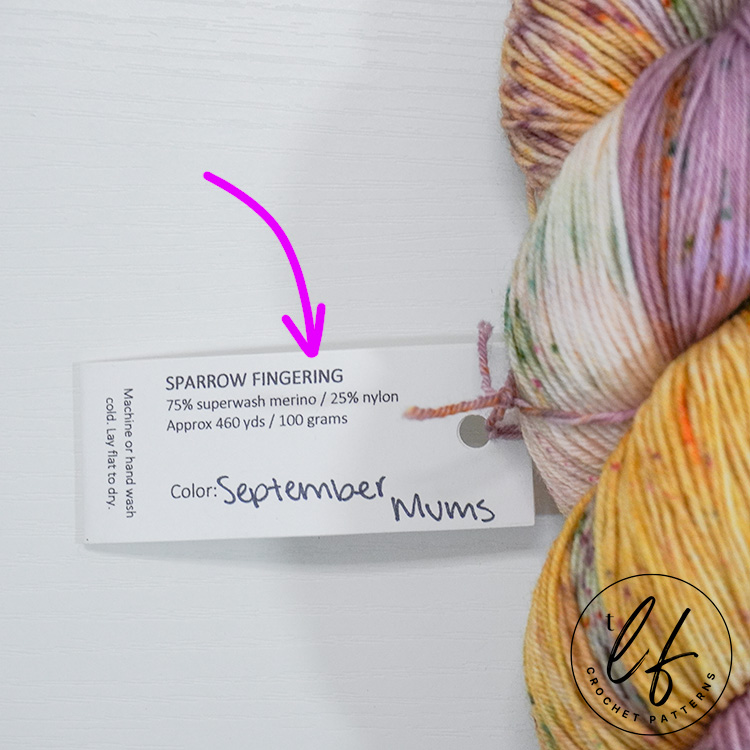
Regardless of how the weight is shown on the label, it will be there. If, for some reason, your label does not have a weight listed on it but you do know what weight it is, I would recommend writing the weight on the label.
What if I have yarn without a label? How do I find out what the yarn weight is?
As crocheters, we end up with a lot of yarn and it’s no surprise that sometimes the skein labels can run off.
Whether we have a decent amount of a skein leftover from a project and the skein label has gone on vacation or we’ve been given yarn without a label, there will come a time when we truly just don’t know what weight the yarn is.
The “best” way to determine the weight of your mystery yarn is by finding out its WPI.
WPI stands for Wraps Per Inch (or approximately 2.5 cm). WPI is most commonly used for weavers but there’s no reason why crocheters can’t also use WPI.
WPI is arguably the best way to figure out the weight of yarn because it mimics an actual unit of measurement.
While there is some wiggle room and it is not totally, 100% accurate, it is the closest we can get to a “real” measurement.
The plus side of WPI is it is incredibly easy to measure.
To measure the WPI of yarn, you’ll need:
- A ruler to wrap the yarn around and measure how many wraps are in an inch.
- A cloth measuring tape can be used to measure but you can’t use one to wrap the yarn around.
- If you only have a cloth measuring tape, you can find something solid, straight and consistent in size to wrap the yarn around.
- A pencil, pen, little firm notebook, a palm sized box – anything solid, straight and easy to wrap yarn around.
We’re looking to measure the thickness of the yarn when the strands are stacked together horizontally, not how much of the yarn is used or how long vertically the wraps are. The width of the wraps will be the same regardless of what you use.
To measure the WPI of your yarn, simply wrap the yarn around whatever solid object you have.
Keep your yarn snug so it stays on your ruler (or other object) but don’t keep it super loose or super tight. Pulling very tight on the yarn can warp the measurement because you may end up stretching the yarn out and it becomes thinner.
The strands of yarn should lay together evenly without any overlapping or gaps.
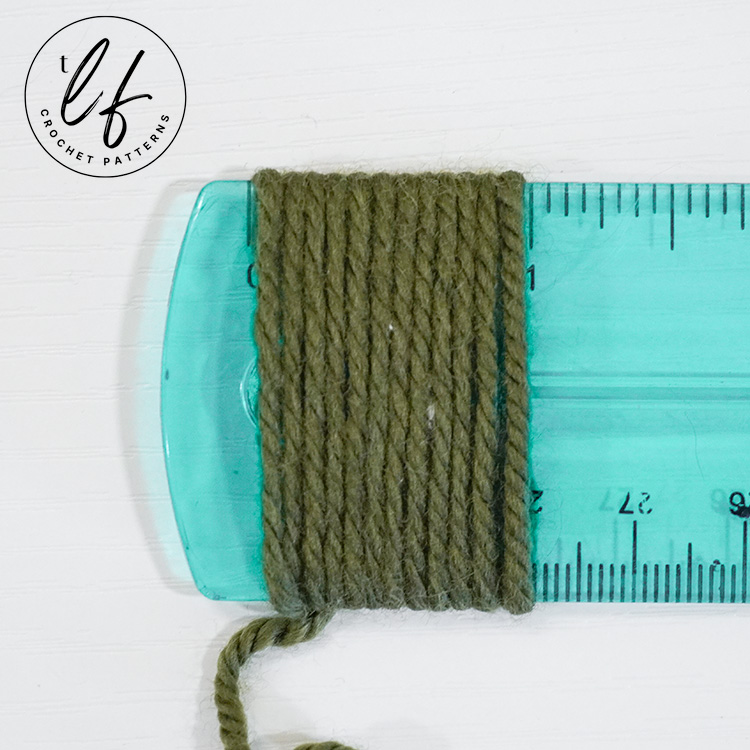
If you’re using a ruler, align the yarn between 0 and 1 inch. Stop wrapping when you get to one inch and then count the number of strands that make up 1 inch. This is your WPI.
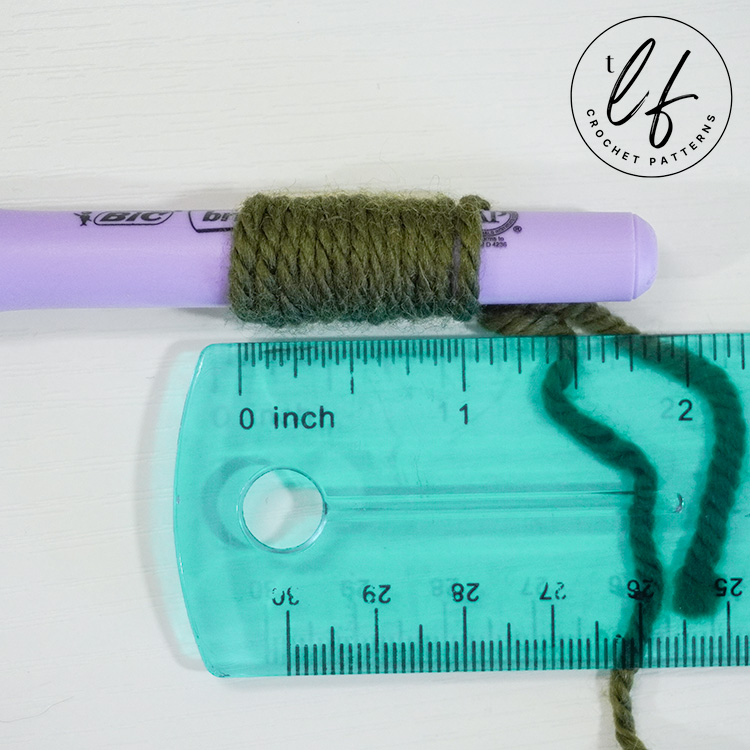
If you’re using something that is not a ruler, continue wrapping until the stack of strands is longer than 1 inch and then measure how many strands make up 1 inch. This is your WPI.
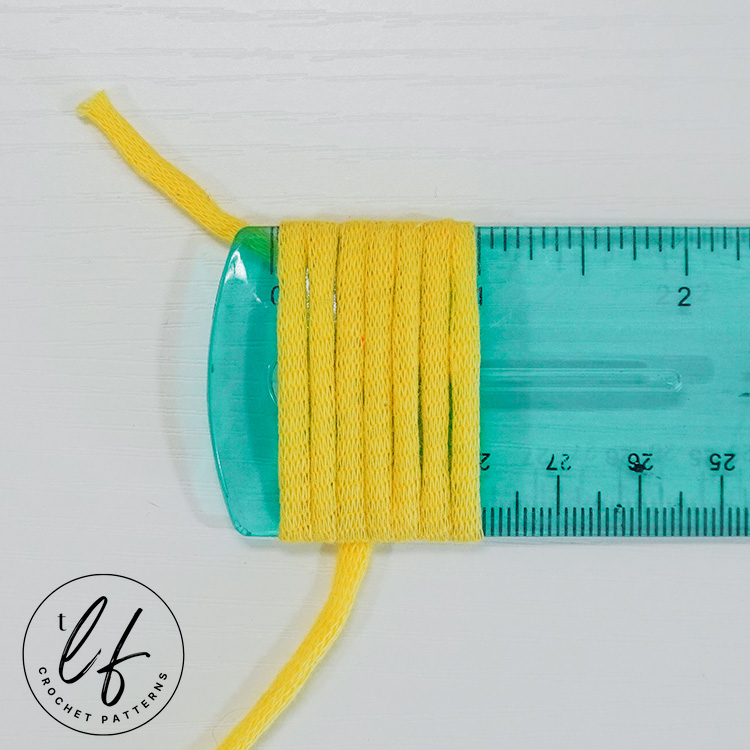
From here, you can see which yarn weight category your yarn falls into by using the table below.
WPI Table to Determine Yarn Weight
| Yarn Weight (US Standard) | WPI (Wraps Per Inch) |
|---|---|
| Lace (0) | 30 to 40+ |
| Super Fine (1) | 14 to 30 |
| Fine (2) | 12 to 18 |
| Light (3) | 11 to 15 |
| Medium (4) | 9 to 12 |
| Bulky (5) | 6 to 9 |
| Super Bulky (6) | 5 to 6 |
| Jumbo (7) | 1 to 4 |
US vs UK vs AUS Yarn Weight Categories and Names
Just like our countries have different ways of doing things, our countries also call yarn different names.
I’m often asked “What is this yarn weight in ply?”
In the US, “Ply” does not mean yarn weight. It means the number of strands spun together to create the yarn. But to for Australian yarn weights (and some UK weights), “Ply” means the weight of the yarn and that’s what they’re asking for.
Conversion between US, UK and Australian Weight Categories can be a little confusing.
Unlike Crochet Hook Sizes, which are created with hard and fast rules of diameter regardless of what the hook is called, yarn weight can be a little subjective to different countries (and even within the same country).
After reviewing several sources, I’ve put together a comparison chart for yarn weights between the US, UK and Australia that you can use.
Yarn Weight Conversion from US to UK to AUS
| USA | UK | AUS |
|---|---|---|
| Lace (0) | 1 ply | 1 ply |
| 2 ply | 2 ply | |
| Super Fine (1) | 3 ply | 3 ply |
| 4 ply | 4 Ply | |
| Fine (2) | 5 Ply | |
| Light (3) | DK | 8 ply |
| Medium (4) | Worsted/Aran | 10 Ply |
| Bulky (5) | Chunky | 12 Ply |
| Super Bulky (6) | Super Chunky | 14 Ply |
| Jumbo (7) | Sometimes called “Roving” | 16 Ply |
Note: This conversion is approximate and may not include the full range of possible yarn weight names, especially for the AUS conversion.
You should consider this yarn weight conversion chart to be a starting point. You should always, always, always do a gauge swatch, especially if your project will be something fitted like a beanie or a sweater.
What’s the difference between US “ply” and AUS “ply”?
First, let’s talk about the definition of Ply as a noun and as a verb.
From Merriam-Webster Dictionary: Ply, as a noun, means “one of several layers usually sewn or laminated together”. They also directly state “one of the strands in a yarn”. As a verb, it means “to twist together”.
Consider plywood. We know that plywood is a sheet of construction material that is made up of several layers of wood. “Plywood”, in this case, would pretty much directly mean “layered or laminated wood”.
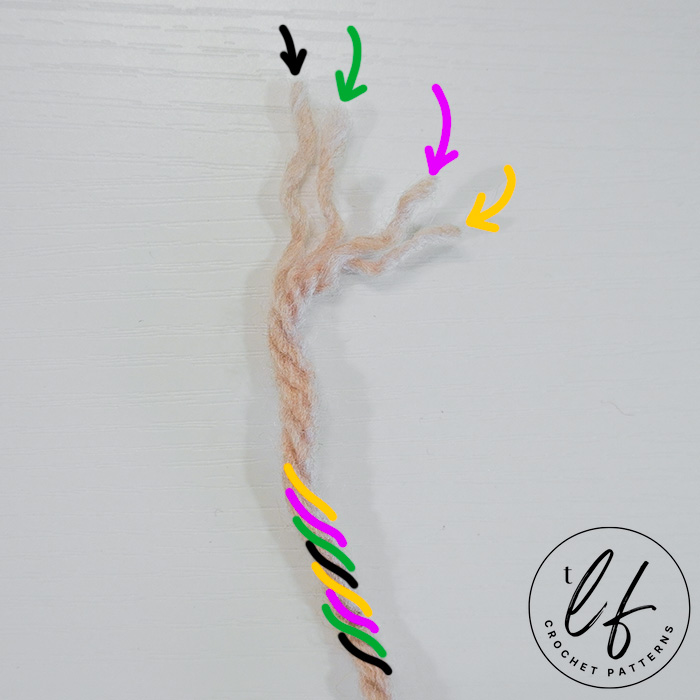
What does ply mean in the US?
In the US, ply refers to the strands of fiber are spun together to create yarn. We do not consider this to be the yarn weight.
Ply isn’t something we refer to often for yarn and, to US designers, ply is not something that is generally important to the pattern.
This is because we have given you the yarn weight in the standard category we use and we have given you our gauge. How many strands of yarn are spun together to create the yarn weight typically doesn’t matter to the pattern we’ve designed.
What does ply mean in Australia?
In Australia (and in some UK yarn weight names), ply refers directly to the yarn weight.
From my research, I discovered this is how it was historically referenced, though this unit of measurement never became “a thing” in the US. When machines began to spin fiber, each ply was the same diameter.
Therefore, to make a yarn weight that’s thicker, they’d ply together more strands of yarn. The number of strands spun together were and are referenced as ply, such as 8 ply. In history, this would have meant that 8 strands of fiber were spun together to create a thicker yarn – hence “8 ply”.
As referenced by The Yarn Queen, ply doesn’t correlate directly with how many strands of fiber are in our modern yarn and may be confusing, even to Australian crocheters.
Machines now can create so many different types of fiber strands or ply that sometimes a yarn weight may be considered “12 ply” (or Bulky) but it’s not actually made with 12 strands.
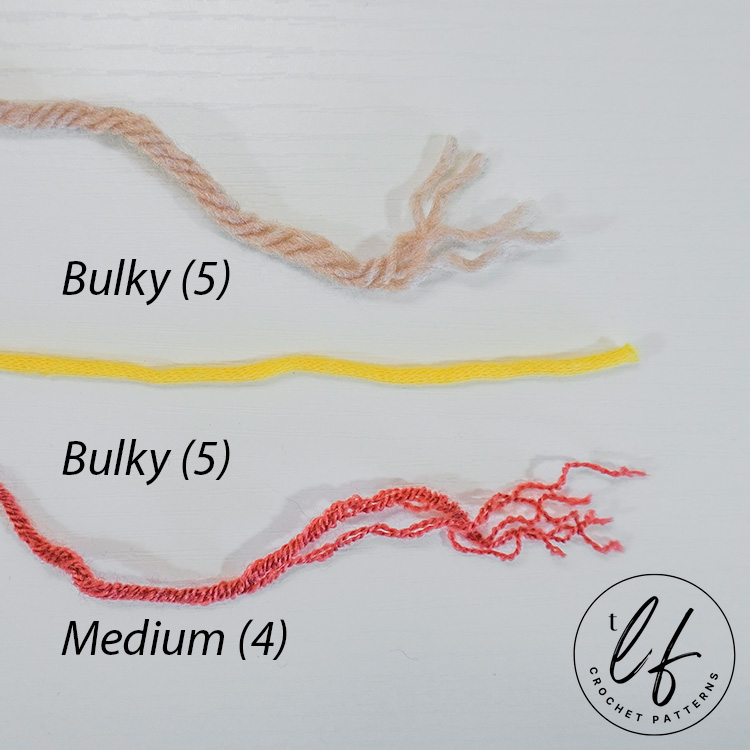
You can see that the number of plies in the yarn does not necessarily correlate directly to what the yarn weight actually is.
None of this is to say that the Australian names are bad or wrong. They aren’t!
It’s interesting to know, though, why ply was originally considered a factual unit of measurement for yarn whereas now, with our modern machines and ability to create different textures of fiber strands that become yarn, it’s not quite as factual but still used.
Is gauge really that important when it comes to yarn weight?
You bet your crochet hooks it is.
The reality is that no yarn will ever be exactly the same. Even in the same brand and manufacturer, there will be slight differences. That’s just the way the world works.
You should always do a gauge swatch to ensure that the yarn you’re using will work well for the pattern you’re following or result in the ideal finished project you want.
My Crochet Gauge Post will walk you through how to make a gauge swatch, why it’s important, what tension means and how our personal tension differs.
But the short answer is: Yes. It matters. Do the gauge swatch even though you really don’t want to. 🙂
FAQ
How do you determine the weight of yarn?
Check your skein label, it will tell you what the weight is. If you have lost the skein label, you can use WPI (Wraps Per Inch) to get an idea of what the yarn weight is.
What yarn weight do I need?
Patterns will tell you what yarn weight you need. If you are following a pattern, the hard part of choosing a yarn weight is done for you.
If you’re planning your own project, you’ll need to think about what your goal is for the finished project and choose a weight of yarn that will help you achieve that.
What are the weights of yarn in order of thickness?
In the US, the order of yarn weight goes from thinnest to thickest.
- Lace – 0 (thinnest/lightest)
- Super Fine – 1
- Fine – 2
- Light – 3
- Medium – 4
- Bulky – 5
- Super Bulky – 6
- Jumbo – 7 (thickest/heaviest)
What is the difference between 3 and 5 weight yarn?
3 (light) weight is 2 standard categories of yarn thinner than 5 (bulky) weight.
Light (3) weight is a very popular yarn that is used for almost any sort of project you can think of. Bulky (5) is still popular but is mostly used for heavier items that you want to work up quickly, like Afghans or beanies.
Are Aran and Worsted yarn the same?
While these terms are sometimes used interchangeably, they’re not the same though they are close. They both fit into the Medium (4) yarn weight category.
Aran is typically thicker than Worsted, though not thick enough to be considered a Bulky (5) weight.
Are all yarns in the same category the same thickness?
No, unfortunately. There’s quite a lot of wiggle room in yarn despite being categorized in the same weight.
This can come down to how it’s manufactured, what the fiber content is, what color it is, etc. This is why it’s always important to do a gauge swatch.
How do I use a different yarn weight for a pattern?
It depends. It really does.
If you’re newer to crochet, it may seem like you can pick up any yarn you like in whatever weight and use it to follow a pattern but this really isn’t the case.
Some patterns are fairly easy to alter to use a different yarn weight. Patterns that are simple, rectangular blankets, for example, are fairly easy to alter based on a gauge swatch. Some designers may even help you do this.
However, sometimes the answer is: “It’s basically not possible”.
This could be because it’s a garment that needs to fit a certain way and changing yarn weight changes everything.
This could be because it’s a pattern with a specific color layout, like my Fledgling Baby Afghan, that requires a certain amount of rows to be worked for the color pattern to work out properly.
Patterns are designed with a specific weight for a reason and it’s not always easy to give a quick answer. In some cases, it would require a complete redesign of the pattern.
Your best option is to kindly reach out to the designer and ask their opinion.
Final thoughts on yarn weight
I know learning all the different weights of yarn can be overwhelming when you’re just starting out. With time and practice (and a few unraveled out projects), you’ll learn what each yarn weight does and doesn’t do – and likely what you’d want to use it for. It becomes instinct. Crochet instinct.
The bright side is no one yarn weight is used for only one specific type of project.
As you’ve likely picked up throughout this article, a lot of the yarn weights are used for a lot of the same items. There’s a lot of overlap in these yarn weights and you can find what you’re looking for within quite a few of them.
The easiest way to remember what these yarn weights mean is to remember: The smaller the number, the thinner the yarn. The thinner the yarn, the lighter the project.
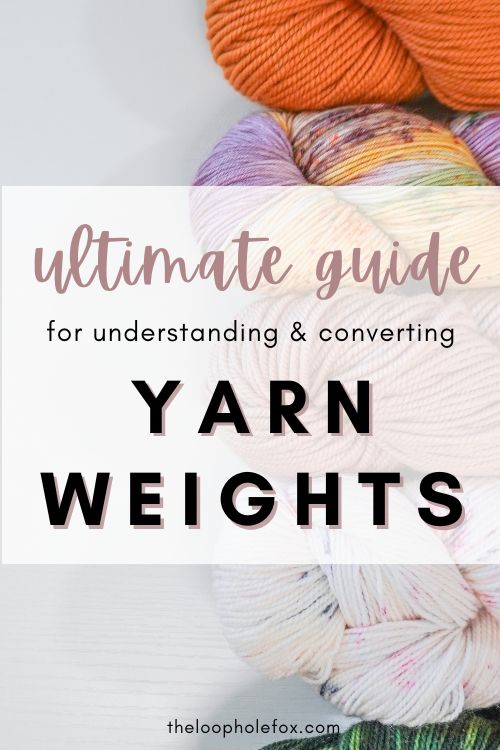
I hope you walk away from this article feeling confident in choosing yarn for your next project!
Happy Crocheting!
Don’t forget to join my Facebook Group so we can chat all about your creations! We are a group for crocheters of all experiences, all interests and love to hang out together. Come join the fun!
Shannon | Designer & Editor
Shannon helps crocheters find their next project and build their skills with in depth tutorials and crochet patterns on her blog, theloopholefox.com.
With more than a decade of crochet experience, Shannon knows that understanding why we do something matters just as much as how we do it. She teaches new techniques and crochet stitches in depth so you can crochet with confidence.
If you loved this article, you might also enjoy my other Crochet Tips and Techniques. Check them out!
